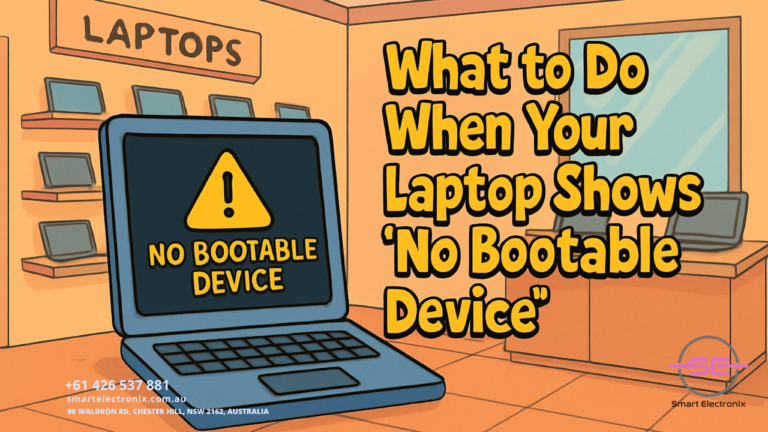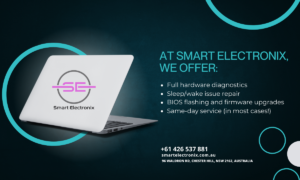
Have you ever turned on your laptop, expecting to jump right into your tasks, only to be greeted by the alarming message: “No Bootable Device Found”? Don’t worry, you’re not alone. At Smart Electronix, we understand how frustrating and even scary this issue can feel. The good news? It’s often fixable.
In this guide, we’ll walk you through exactly what this message means, the potential causes, and the steps you can take to solve it. Let’s dive into this common yet solvable laptop issue.
What Does “No Bootable Device” Mean?
When your laptop says “No Bootable Device,” it means your system can’t find a drive that contains the necessary files to boot (start) the operating system. In simple terms, your computer doesn’t know where Windows or macOS is located.
This usually happens because your bootable drive (often your SSD or HDD) is not being detected or has become corrupted.
Common Causes of “No Bootable Device” Error
Understanding the reason behind this error is the first step to fixing it. Here are the most frequent culprits:
- Incorrect BIOS/UEFI Settings
- Loose or Disconnected Drive Cables
- Corrupted Boot Sector or System Files
- Damaged or Failing SSD/HDD
- Accidental Deletion of Boot Files
- Drive Not Set as Primary Boot Device
Step-by-Step Troubleshooting Guide
Here at Smart Electronix, we recommend following these steps to resolve the issue. If you’re not comfortable with technical processes, it’s best to consult a technician.
1. Restart and Check Again
Sometimes it’s just a glitch. Start by restarting your laptop. You’d be surprised how often this simple step fixes things.
2. Enter BIOS/UEFI Settings
- Turn off your laptop.
- Turn it back on and immediately press the BIOS key (usually F2, F10, Del, or Esc).
- Once in BIOS, check if your SSD or HDD is listed.
If it isn’t, your drive might be physically disconnected or faulty.
3. Check Boot Order
 Inside the BIOS, ensure the correct drive is set as the first boot device.
Inside the BIOS, ensure the correct drive is set as the first boot device.
- Navigate to the Boot tab.
- Set your primary SSD or HDD to the top of the list.
Save the changes and reboot.
4. Check for Loose Connections
If you have the skills, power off the laptop, remove the back panel, and make sure your storage drive is properly connected. A loose SATA or M.2 connection can cause this error.
5. Run a Startup Repair
If your laptop detects the drive but won’t boot, use a Windows installation USB to run a Startup Repair:
- Boot from the USB.
- Select “Repair your computer”.
- Choose “Troubleshoot” > “Startup Repair”.
6. Use Command Prompt for Advanced Repair
If Startup Repair fails, use Command Prompt:
- Run the following commands one by one:
bootrec /fixmbr bootrec /fixboot bootrec /scanos bootrec /rebuildbcd - Restart the computer.
7. Check the SSD/HDD Health
A failing storage device may cause this issue. Tools like CrystalDiskInfo (for Windows) or Disk Utility (for macOS) can help assess drive health.
If the drive is faulty, you’ll need a replacement.
Prevention Tips from Smart Electronix
To avoid facing this stressful situation in the future, follow these best practices:
- Back up your data regularly.
- Avoid force-shutting down your system.
- Use antivirus software to prevent boot sector viruses.
- Don’t delete system files unless you’re 100% sure.
- Schedule occasional disk checks.
When to Contact Smart Electronix
If you’ve tried the steps above and the problem persists, don’t panic. Our expert technicians at Smart Electronix can quickly diagnose the issue and offer the most cost-effective solution – whether that’s a software fix or a hardware replacement.
We specialize in laptop repair services, SSD upgrades, and complete system diagnostics across Australia.
Final Thoughts
Seeing a “No Bootable Device” message can definitely ruin your day, but it doesn’t have to ruin your laptop. With a bit of patience, the right steps, and professional help from Smart Electronix, you can get your device up and running again.
Need help right now? Visit our official website at smartelectronix.com.au or drop by one of our service centers near you.
 Let Smart Electronix handle your tech, so you can get back to what matters most.
Let Smart Electronix handle your tech, so you can get back to what matters most.
